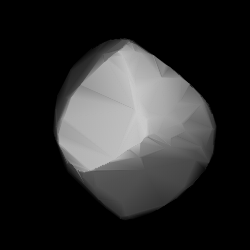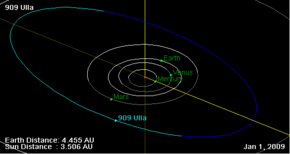
936 Kunigunde is a dark Themistian asteroid from the outer regions of the asteroid belt, approximately 40 kilometers in diameter. It was discovered on 8 September 1920, by German astronomer Karl Reinmuth at the Heidelberg-Königstuhl State Observatory. The carbonaceous B-type asteroid has a rotation period of 9.4 hours. It was named "Kunigunde", a common German female name unrelated to the discoverer's contemporaries, that was taken from the almanac Lahrer Hinkender Bote.
940 Kordula is a large and dark Cybele asteroid from the outermost region of the asteroid belt, approximately 80 kilometers in diameter. It was discovered on 10 October 1920, by astronomer Karl Reinmuth at the Heidelberg-Königstuhl State Observatory in Germany. The carbonaceous F-type asteroid (FC) has a rotation period of 15.6 hours. It was named "Kordula", a common German female name unrelated to the discoverer's contemporaries, that was taken from the almanac Lahrer Hinkender Bote.

950 Ahrensa, provisional designation 1921 JP, is a stony Phocaea asteroid and slow rotator from the inner regions of the asteroid belt, approximately 15 kilometers in diameter. It was discovered on 1 April 1921, by German astronomer Karl Reinmuth at Heidelberg Observatory in southern Germany.
973 Aralia is an asteroid of the Ursula family located in the outer regions of the asteroid belt, approximately 52 kilometers in diameter. It was discovered on 18 March 1922, by German astronomer Karl Reinmuth at the Heidelberg Observatory in southern Germany. The Xk-type asteroid has a rotation period of 7.3 hours. It was named after the genus of ivy-like plant Aralia, also known as "spikenard".
997 Priska, provisional designation 1923 NR, is a carbonaceous Adeonian asteroid from the central regions of the asteroid belt, approximately 19 kilometers in diameter. It was discovered on 12 July 1923, by astronomer Karl Reinmuth at the Heidelberg-Königstuhl State Observatory in southwest Germany. The asteroid's name is a common German female name, unrelated to the discoverer's contemporaries.
1143 Odysseus, provisional designation 1930 BH, is a large Jupiter trojan located in the Greek camp of Jupiter's orbit. It was discovered on 28 January 1930, by German astronomer Karl Reinmuth at the Heidelberg Observatory in southwest Germany, and later named after Odysseus, the legendary hero from Greek mythology. The dark D-type asteroid has a rotation period of 10.1 hours. With a diameter of approximately 125 kilometers, it is among the 10 largest Jovian trojans.
Belopolskya, provisional designation 1923 OS, is a dark Cybele asteroid from the outermost region of the asteroid belt, approximately 75 kilometers (47 mi) in diameter. It was named for Russian astrophysicist Aristarkh Belopolsky.
1051 Merope is a dark Alauda asteroid from the outermost region of the asteroid belt, approximately 68 kilometers in diameter. It was discovered on 16 September 1925, by German astronomer Karl Reinmuth at the Heidelberg-Königstuhl State Observatory in Heidelberg, Germany, and given the provisional designation 1925 SA. Reinmuth named it after the nymph Merope from Greek mythology. The asteroid has a rotation period of 27.2 hours.

1087 Arabis is a stony Eoan asteroid from the outer regions of the asteroid belt, approximately 35 kilometers in diameter. It was iscovered by Karl Reinmuth at the Heidelberg Observatory in 1927 and assigned the provisional designation 1927 RD. The asteroid was named after the flowering plant Arabis (rockcress).

1095 Tulipa is an Eos asteroid from the outer regions of the asteroid belt. It was discovered by German astronomer Karl Reinmuth at the Heidelberg-Königstuhl State Observatory in southwest Germany on 14 April 1926. The assumed S-type asteroid has a rotation period of 2.8 hours and measures approximately 30 kilometers in diameter. It was named after the flower Tulip. Originally, the name was redundantly assigned to Florian asteroid 1449 Virtanen.
1101 Clematis is an Alauda asteroid from the outermost regions of the asteroid belt, approximately 37 kilometers in diameter. It was discovered on 22 September 1928, by German astronomer Karl Reinmuth at the Heidelberg-Königstuhl State Observatory in southwest Germany, and assigned the provisional designation 1928 SJ. It was named for the flowering plant Clematis. The presumably carbonaceous asteroid has a relatively long rotation period of 34.3 hours.

1105 Fragaria is an Eos asteroid from the outer regions of the asteroid belt. It was discovered on 1 January 1929, by German astronomer Karl Reinmuth at the Heidelberg Observatory in southwest Germany, and assigned the provisional designation 1929 AB. The S-type asteroid (ST/L) has a rotation period of 5.4 hours and measures approximately 37 kilometers in diameter. It was named after the flowering plant Fragaria (strawberry).

1404 Ajax is a carbonaceous Jupiter trojan from the Greek camp, approximately 83 kilometers kilometers in diameter. It was discovered on 17 August 1936, by German astronomer Karl Reinmuth at Heidelberg Observatory in southern Germany, and named after the legendary warrior Ajax from Greek mythology. The assumed C-type asteroid belongs to the 40 largest Jupiter trojans and has a longer than average rotation period of 29.4 hours.

1437 Diomedes is a large Jupiter trojan from the Greek camp, approximately 150 kilometers in diameter. It was discovered on 3 August 1937, by astronomer Karl Reinmuth at the Heidelberg-Königstuhl State Observatory in southwest Germany. The dark D/P-type asteroid belongs to the largest Jupiter trojans and has a notably elongated shape and a longer than average rotation period of 24.49 hours. Diomedes was the first Jupiter trojan successfully observed during an occultation event of star. It was named after the hero Diomedes from Greek mythology.
1234 Elyna, provisional designation 1931 UF, is an Eoan asteroid from the outer regions of the asteroid belt, approximately 25 kilometers in diameter. It was discovered on 18 October 1931, by astronomer Karl Reinmuth at the Heidelberg-Königstuhl State Observatory. The asteroid was named after the flowering plant Elyna.
1308 Halleria, provisional designation 1931 EB, is a carbonaceous Charis asteroid from the outer regions of the asteroid belt, approximately 43 kilometers in diameter. It was discovered on 12 March 1931, by German astronomer Karl Reinmuth at the Heidelberg-Königstuhl State Observatory. The asteroid was named after Albrecht von Haller a Swiss physician, botanist and poet.
1174 Marmara, provisional designation 1930 UC, is a stony Eoan asteroid from the outer regions of the asteroid belt, approximately 17 kilometers in diameter. It was discovered on 17 October 1930, by German astronomer Karl Reinmuth at Heidelberg Observatory in southwest Germany. The asteroid was later named after the Sea of Marmara, located between Europe and Asia.

1256 Normannia is a dark Hilda asteroid and slow rotator from the outermost regions of the asteroid belt, approximately 69 kilometers in diameter. It was discovered on 8 August 1932, by astronomer Karl Reinmuth at the Heidelberg-Königstuhl State Observatory in Germany. The asteroid was likely named after the Normans who gave their name to the region of Normandy in France.

1249 Rutherfordia, provisional designation 1932 VB, is an elongated, stony Florian asteroid from the inner regions of the asteroid belt, approximately 13 kilometers in diameter. Discovered by Karl Reinmuth at Heidelberg Observatory in 1932, the asteroid was named after Rutherford, New Jersey a suburb of New York City, United States.
1481 Tübingia, provisional designation 1938 DR, is a dark asteroid from the outer region of the asteroid belt, approximately 34 kilometers in diameter. It was discovered on 7 February 1938, by German astronomer Karl Reinmuth at Heidelberg Observatory in southern Germany, and named for the German city of Tübingen.









